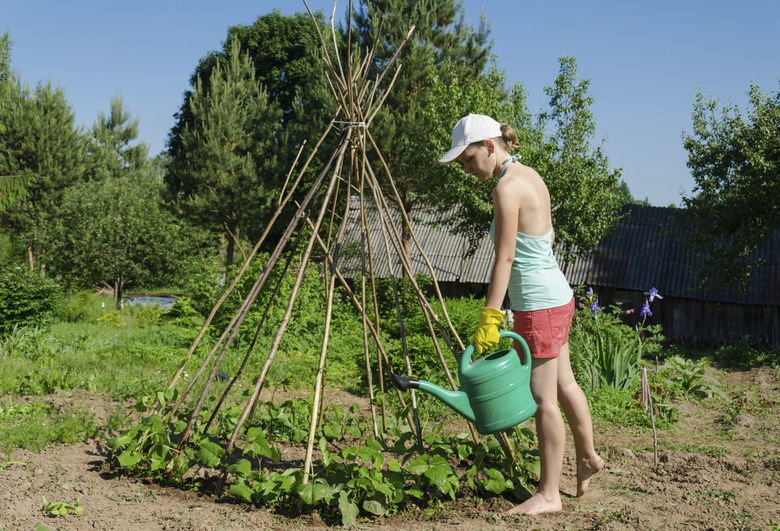How Often Should I Water My Vegetable Garden?
How often should-fertilize-vegetable-garden.html'>a vegetable garden needs water depends on the weather, soil type, growth stage of the vegetables and other factors. Underwatering causes stringy, strongly flavored vegetables, but overwatering increases the risk of plant diseases and reduces vegetables' flavor. When in very wet soil, plants' roots drown, causing the plants to die. Signs of underwatering and overwatering in plants include pale, wilted leaves and poor growth. Regularly checking the soil moisture level gives the best indication of how often to water a vegetable garden.
Checking the Soil
Different kinds of soil hold water better than other kinds. Clay soils hold onto moisture, but sandy soils drain freely. A vegetable garden in any kind of soil needs water when the soil is dry to a depth of 2 inches, which is usually about once every four days during hot weather. A garden with clay soil may need water less frequently, and a garden in sandy soil may need water more often.
You can test soil's moisture level by pushing your fingers into the soil. Dry soil feels dry to the touch. Another test method is to insert a screwdriver or stick into the soil. Moist soil clings to a screwdriver or stick and looks darker than dry soil. Houseplant soil moisture meters are also useful for measuring soil moisture but are sometimes inaccurate.
If the soil is moist just below the soil surface, then usually it also is moist at vegetable plants' root zones, 6 to 8 inches deep. If you want to check deep soil's moisture level, then dig a hole 8 inches deep, and feel the soil at the hole's bottom.
Knowing Plants' Water Needs
Besides vegetable plants' growth stages, the kinds of vegetables in the garden also affect how often the garden needs water. For example, the annual vegetables corn (Zea mays) and bush beans (Phaseolus vulgaris) need more water when silking and flowering than during their other growth stages. Low soil moisture from those stages until harvest reduces crop yields in corn, beans and other summer vegetables.
Apply water to the garden when its soil surface is dry after sowing vegetables and until the seedlings are 4 to 5 inches tall. The soil for growing young vegetable plants should stay consistently moist to a depth of 3 to 4 inches. During hot dry weather, the garden may need watering every day.
Watering the Garden
Equipment for watering a vegetable garden includes garden hoses, watering cans, drip-irrigation systems, soaker hoses and sprinklers. Sprinklers are usually a poor choice because some of their water evaporates, and their water falls over the whole garden bed, which encourages leaf diseases and weeds. Applying water at the plant bases is the best method for watering a vegetable garden.
Connect a fine-spray rose device to a watering can or a soft-spray attachment to a garden hose for watering vegetable seeds and seedlings as well as other delicate plants. Apply water to the soil until it begins to puddle on the soil surface.
Drip-irrigation systems and soaker hoses supply water at plant bases through emitters or perforated hoses, which are connected to a water supply. These devices take time to install but reduce the time spent watering over the long term.
Saving Water
Mulches and weed control help save water in a vegetable garden. Water-permeable landscape fabric, paper and organic mulches such as straw, compost, wood shavings, rice hulls and bark placed on the soil surface reduce water evaporation from the surface. Weight landscape fabric and paper with stones to prevent wind from lifting them. Spread a layer of an organic mulch 3 or 4 inches thick around vegetable plants. Don't allow mulches to touch vegetable stems, or else the stems may rot.
Weeds compete with vegetable plants for water. Remove weeds growing near your vegetables by pulling them upward out of the soil, and shallowly hoe the rest of the vegetable garden once per week.
References
- Colorado State University Extension: Irrigating the Vegetable Garden
- North Carolina Cooperative Extension: How to Water Vegetables and Herbs
- University of California, Vegetable Research and Information Center: Saving Water in Vegetable Gardens
- Missouri Botanical Garden: Zea Mays
- Cornell University: Growing Guide — Bush Beans
